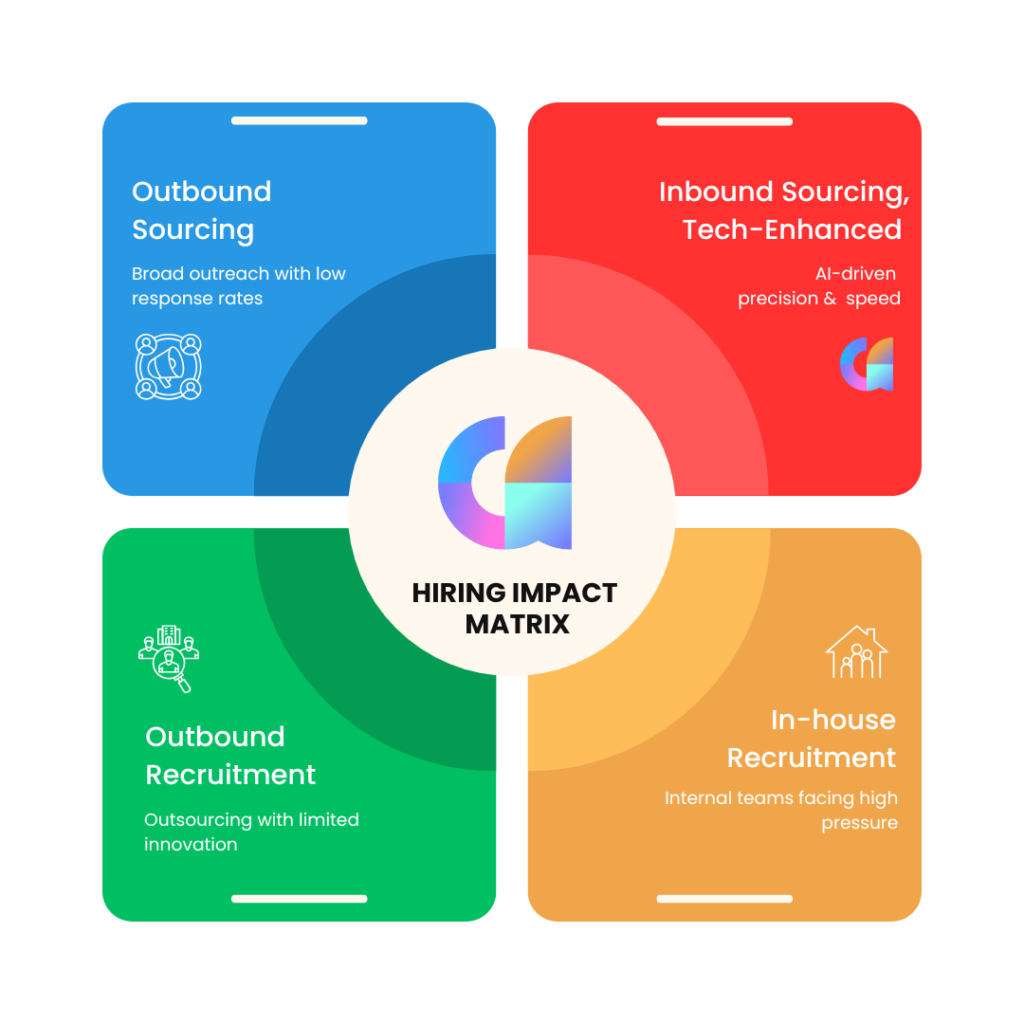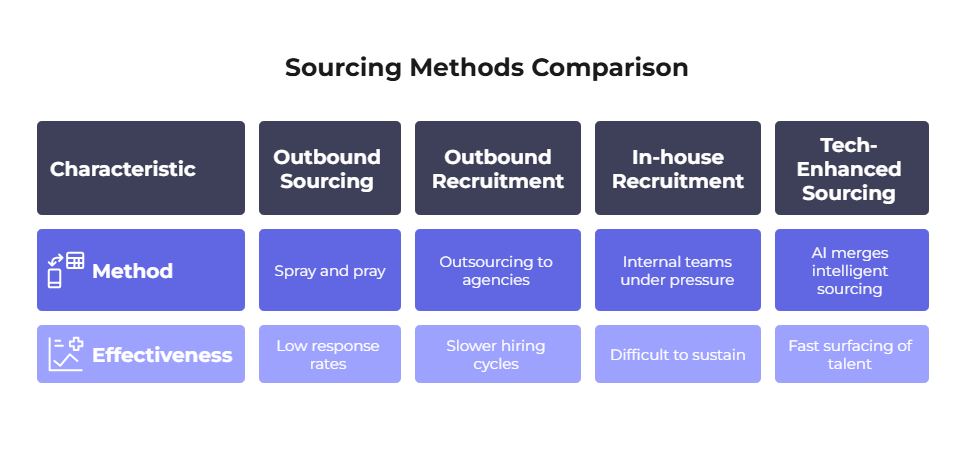Based on insights from industry leaders and real-world recruitment challenges
The recruitment landscape has never been more complex. With talent shortages across industries, evolving candidate expectations, and the rapid adoption of AI hiring software, HR professionals are navigating uncharted territory. During a recent industry discussion, recruitment experts painted a stark picture of the current state of talent acquisition—one that demands immediate attention and strategic evolution.
“TA teams are going to implode,” warned one industry veteran. “They can’t handle once the volume starts to come back in… they don’t have the mechanism and the tools to be able to do so, especially in an environment where you’ve got the AI war happening.”
To make sense of this complexity and the challenges facing today’s recruiters, we’ve mapped the current state of talent acquisition into four distinct quadrants—each representing a different approach to finding and securing top talent.

The Talent Acquisition Matrix: Four Distinct Approaches
Quadrant 1: Outbound Sourcing (The “Spray and Pray” Reality)
What it is: Traditional outbound sourcing involves recruiters actively reaching out to potential candidates through LinkedIn messages, cold emails, and direct contact.
The harsh reality: As one industry expert bluntly stated during our discussion: “Outbound sourcing is quite problematic because people never reply to their LinkedIn connection requests or reply to any messages or emails.” The numbers support this frustration—response rates to LinkedIn connection requests hover around 15-20%, while cold email responses are even lower.
Why it fails: Recruitment has been catastrophically influenced by digital email marketing—a disastrous approach that’s fundamentally ill-advised for career-related communications. While advertising roles matters, the numbers reveal a stark reality: email penetrative impact barely reaches 3% open rates, even when promising 90% efficiency gains.
The fundamental paradox is staggering—we’re telling candidates we have the “right role” for them while they face a 0.001% chance of actually making it through the process. The mathematics simply don’t add up. As one recruiter noted, “You have to go to a lot of this lead generation, you know?”
Our comprehensive review of traditional outbound tools shows a sobering truth: the percentage that have genuinely helped improve recruitment outcomes is 0%. This volume-based mentality not only yields poor results but wastes valuable time and resources while potentially damaging employer brand.
The bottom line: While outbound sourcing isn’t dead, it requires significant refinement to be effective in today’s market. The current approach is unsustainable and increasingly ineffective.
Quadrant 2: Outbound Recruitment (Outsourced Inefficiencies)
What it is: Companies outsource their outbound recruitment efforts to external agencies or RPOs (Recruitment Process Outsourcing providers).
The challenge: As highlighted in our industry discussion, outbound recruitment “is very prohibitive” because agencies often “do the same approach, but you just outsource it to somebody else.” Many agencies simply replicate the same inefficient outbound strategies at scale, without bringing innovation or advanced recruitment technology to the table.
The result: Organizations end up with slower hiring cycles and minimal visibility into the recruitment process, while paying premium fees for the same problematic approaches they could execute internally.
When it works: Outsourced recruitment can be effective when agencies bring specialized expertise, industry knowledge, or advanced tools that internal teams lack. However, success depends heavily on choosing partners who can demonstrate genuine value beyond traditional methods.
Key consideration: Organizations must evaluate whether their recruitment partners are adding genuine value or simply scaling existing problems at a higher cost.
Quadrant 3: In-House Recruitment (The Pressure Cooker)
What it is: Internal talent acquisition teams handling all recruitment activities using their own resources and processes.
The mounting pressure: In-house TA teams know their company culture and requirements better than anyone, but they’re facing unprecedented challenges. As one industry expert observed, these teams are “highly pressurised” and struggling with the reality that “they don’t have the tools to do it.”
The perfect storm: Several factors are creating unsustainable conditions:
- Massive application volumes requiring manual screening
- Pressure to reduce time-to-hire while maintaining quality
- Limited access to modern recruitment tools and AI hiring software
- The emergence of what experts call “the AI war” in recruitment
- Tons of applications coming through at any given time
The risk of implosion: The warning from industry leaders is clear: “TA teams are going to implode. They can’t handle once the volume starts to come back in… they don’t have the mechanism and the tools to be able to do so.” Without proper technological support, many teams are reaching a breaking point.
The path forward: In-house teams desperately need investment in AI capabilities, insights, and inference tools to support better decision-making. As one expert noted, teams need to “lean on the tools, the AI capability and the AI insight” to survive and thrive.
Quadrant 4: Tech-Enhanced Inbound Sourcing (The Partnership Solution)
What it is: Advanced recruitment strategies that leverage AI hiring software, data analytics, and automation to attract, identify, and engage top-tier candidates proactively.
Why it’s transformative: This approach represents a fundamental shift from being “just another tool” to becoming a true partnership. Leading solutions in this space combine intelligent AI sourcing with contextual screening and automated insights to surface top-tier talent fast.
The partnership difference: Rather than simply providing technology, the best solutions offer:
- Intelligent AI sourcing that goes beyond keyword matching
- Contextual screening that understands role requirements and cultural fit
- Automated insights that help teams make data-driven decisions quickly
- Visibility, precision, and agility to move quickly on best-fit candidates
- Support for high-volume environments without sacrificing quality
The competitive advantage: Organizations operating in this quadrant can move faster, make better hiring decisions, and provide superior candidate experiences—all while reducing recruiter workload. As industry leaders note, the focus shifts from volume-based activities to strategic relationship-building and partnership-driven approaches.
The evolution: This quadrant represents the natural evolution from traditional recruitment methods to AI-enhanced, insight-driven talent acquisition that treats technology providers as strategic partners rather than vendors.
The AI Revolution in Recruitment: Context from the Frontlines

The integration of AI hiring software is no longer a luxury—it’s becoming essential for survival in what industry experts call “the AI war” in recruitment. This isn’t just about adopting new technology; it’s about completely reimagining how talent acquisition operates in an environment with unprecedented application volumes.
The volume challenge: Modern TA teams are dealing with “tons of applications coming through at any given time,” creating an unsustainable manual workload. Traditional screening methods simply can’t keep pace with this volume while maintaining quality standards.
AI as a strategic enabler: Advanced recruitment platforms are transforming how organizations handle this challenge by providing:
Intelligent candidate identification: AI algorithms can scan massive databases to identify candidates who might not appear in traditional searches but possess the right combination of skills and potential for success.
Predictive hiring analytics: Machine learning models analyze successful hires to identify patterns and predict which candidates are most likely to succeed in specific roles, helping teams make better decisions faster.
Automated engagement at scale: Intelligent systems can handle initial candidate interactions and screening processes, freeing recruiters to focus on relationship-building and strategic activities.
Real-time performance insights: Data analytics offer immediate visibility into recruitment performance, bottlenecks, and optimization opportunities, enabling continuous improvement.
The partnership difference: The most effective AI hiring software solutions don’t just provide tools—they offer insights, inference capabilities, and strategic support that help TA teams make better decisions under pressure.
Strategic Recommendations for Modern HR Leaders
Assess Your Current Position
Map your current recruitment activities across the four quadrants. Are you relying too heavily on ineffective outbound sourcing? Is your in-house team showing signs of strain? Understanding where you currently operate is the first step toward strategic evolution.
Invest in AI-Enhanced Tools, Not Just Technology
Modern recruitment requires modern tools, but as industry experts emphasize, it’s not just about the technology—it’s about finding partners who can provide “AI capability and AI insight and inference to support you to be able to make the right decision.” Evaluate solutions that offer genuine partnership, not just software.
Prioritize Relationship-Driven Approaches
Despite technological advances, recruitment remains fundamentally about relationships. As one expert noted, much of the value comes from “working with the people.” Ensure your technology enhances rather than replaces the human elements that make recruitment successful.
Develop a Hybrid Strategy
The most successful organizations don’t rely on a single quadrant. They combine targeted outbound efforts, strong inbound attraction, and intelligent technology to create a comprehensive talent acquisition strategy that can handle high volumes without sacrificing quality.
Seek Feedback and Iterate
Industry leaders consistently emphasize the value of feedback and continuous improvement. Base your strategic decisions on real-world insights from both candidates and internal stakeholders, not just theoretical best practices.
Measure What Matters
Implement metrics that go beyond time-to-hire and cost-per-hire. Track quality of hire, candidate satisfaction, recruiter efficiency, and long-term retention to optimize your approach and demonstrate ROI.
The Road Ahead: Learning from Industry Reality
The talent acquisition landscape will continue to evolve rapidly, but the insights from frontline recruitment professionals paint a clear picture of what needs to change. As one industry expert reflected, the value comes from “working with the people” and maintaining a “relationship-driven” approach, even as technology transforms the underlying processes.
The partnership imperative: Organizations that recognize the limitations of traditional approaches and embrace technology-enhanced recruitment strategies will have a significant competitive advantage. But success isn’t just about adopting AI hiring software—it’s about finding true partners who understand the complexity of modern talent acquisition.
The urgency factor: With TA teams facing potential “implosion” and the “AI war” creating both opportunities and challenges, the window for strategic evolution is narrowing. Companies that wait too long to modernize their recruitment approach risk being left behind by more agile competitors.
The choice is clear: evolve your recruitment strategy now, or risk being left behind in an increasingly competitive talent market where speed, precision, and partnership-driven approaches determine success.






